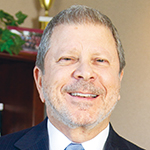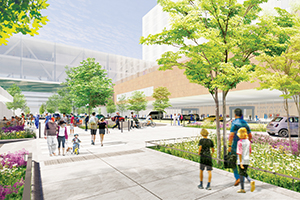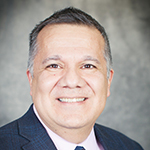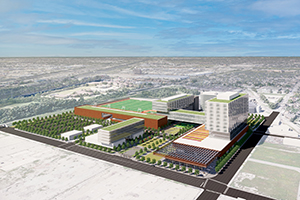While it's taken a decade to get to this point, the ground has been cleared — literally and figuratively — for a mixed-use development on the southwest side of Chicago that will be anchored by a new Saint Anthony Hospital.
The Chicago City Council agreed in April 2021 to sell the last parcel for the project, an 11-acre tract that was once supposed to be donated by the city. In January, the council unanimously approved the zoning plan for the development, to be called the Focal Point Community Campus.

Crews demolished the last of the structures on the 30-acre site this spring. The project is now moving toward its next phase, contaminated soil removal. If there are no other unforeseen delays, Guy A. Medaglia, Saint Anthony Hospital's president and chief executive, says construction will start early next year.
Medaglia expects the project to "usher a new era of hope into a community that has seen too much disinvestment for way too long."

Mixed-use campus
The new hospital will have 150 inpatient beds, just like the current one, with an emergency department and intensive care, pediatrics, maternity and behavioral health among its services. Medaglia describes a state-of-the-art facility with a wall-sized monitor in each of the private patient rooms that can display information about the patient's condition and the medical team. Dedicated corridors will give nonclinical staff such as dietary and environmental services workers access to patient rooms without having their carts add to the traffic in main hallways.
Besides the hospital, the campus will have affordable housing, an outpatient clinic, educational centers for children and adults, a recreation center, athletics fields and green space, a venue for private events and retail shops.
The building site is 1.5 miles from the 126-year-old Saint Anthony Hospital, a Catholic nonprofit facility unaffiliated with a larger system.
The new campus and the existing hospital are in a section of the city largely populated by working-class or impoverished families, many of them Black, Hispanic or Asian and many of them immigrants.
Community on the margins
Jim Sifuentes, senior vice president of mission and community development at Saint Anthony, says those it serves are largely marginalized, in that they have limited access to health care, employment and other critical planks on the ladder to social and economic advancement.

"Much of the poverty that we see in these communities has continued for generations for a lot of systemic reasons," Sifuentes says.
The plans for the Focal Point campus stretch back to the administration of Mayor Richard M. Daley, who left office in 2011. Medaglia says the mayor came to visit Saint Anthony and left so impressed with its community outreach and programs that he wanted to hand over the blighted 11-acre parcel to build a replacement hospital for $1.
That plan got bogged down in what Medaglia calls city politics, with Daley's successors hedging on and rethinking the commitment. In the end, the Chicago Southwest Development Corporation, the not-for-profit set up to build and manage the Focal Point Community Campus, paid the city $5 million for the parcel. Medaglia says the price was much higher than what the corporation, which he heads, paid for any of the other tracts.
Residents weigh in
The size and plans for the Focal Point campus grew in the many years since it was first envisioned. Medaglia and Sifuentes say that is a result of input from residents of the surrounding neighborhoods. At forums that Saint Anthony hosted about the project, residents said they wanted not just quality health care but childcare, programs to keep kids off the streets, vocational training and more.
"That's how we realized that the initial 11 acres that the city was going to sell us was really not enough," Medaglia says. It also became clear that those programs couldn't be financed on hospital revenue alone, which comes mostly from Medicaid and other public insurance programs.
That led Medaglia to the plan for a self-sustaining development with a mix of public and private enterprises, all of which will pay rent to Chicago Southwest Development Corporation to fund operations and community programs.
The budget for the construction of the campus, estimated at $600 million, relies on $143 million from federal, state and city grants and loans; $200 million in private donations; and $257 million in commercial loans. To date, about $37 million has been spent to buy property and do prep work on the site.

Saint Anthony has invited ongoing input from community residents and leaders and business owners and it is keeping all these stakeholders informed of its progress on the redevelopment project.
Seeding grassroots programs
Once the campus is in full operation, Medaglia says the financial plan shows it will generate $7 million more than needed to cover costs every year. He adds that the extra funds will be awarded in grants to not-for-profit organizations serving the surrounding community.
Sifuentes says that is one way the campus will be transformational to the approximately 440,000 people who live within its service area. The grants will be a reliable source of funding for the many church and community organizations that address food and housing insecurity and other social issues that affect health and well-being.
Campus planners also expect it to generate many jobs, starting with 3,500 for construction and ending with about 1,200 at the new hospital, 500 at the retail shops and 400 from the various programs.
The goal of the campus, Medaglia and Sifuentes say, is not to gentrify the surrounding neighborhoods but to bring in needed services and provide amenities and facilities enjoyed in more prosperous parts of the city.
Aware of the high incidence of asthma in the hospital's catchment area as well as lingering outrage about an earlier demolition project that blanketed the same Chicago neighborhoods in dust, the Chicago Southwest Development Corporation worked with the excavator demolishing buildings to set up a dashboard in several languages with information about dust remediation and air quality.
"It just makes sense if these are the people that are going to be using your hospital, you want to build trust, you want to build a relationship," Medaglia says. "And so how we build this, how we communicate with the communities that are involved, is critical for the success of the project."
Landing the moonshot
Even as the city of Chicago let the plans for the Focal Point campus languish, it drew attention from elsewhere as a model for sustainable developments. Medaglia went to Canada with representatives of the architectural firm that designed the campus, HDR, to discuss the concept with a top official in that nation's health care system. He got a similar invitation from the United Kingdom, which was scuttled because of the COVID-19 pandemic.
Medaglia says getting the campus zoning plan and property sale approved by the city took a sustained effort and some of the funding has yet to be secured. He's nevertheless confident that the project will be completed in late 2025 to early 2026.
As the project moves along, he's hoping elected officials and donors will put financial support behind the praise they have voiced for the project. "It's one thing to say, 'Wow, this is a great, it's a transformational project,' but how are they helping?" he says. "I just expect more people to help more."
